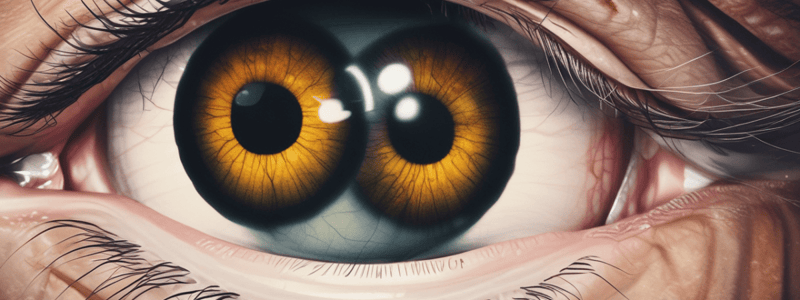Podcast
Questions and Answers
Which drug is the first choice for reducing aqueous humor production in glaucoma?
Which drug is the first choice for reducing aqueous humor production in glaucoma?
- Brimonidine
- Latanoprost
- Betaxolol (correct)
- Pilocarpine
What are the two main mechanisms by which drugs can lower intraocular pressure (IOP)?
What are the two main mechanisms by which drugs can lower intraocular pressure (IOP)?
Facilitating aqueous humor outflow and reducing aqueous humor production.
Angle-closure glaucoma is painless.
Angle-closure glaucoma is painless.
False (B)
Pilocarpine induces ______ which indirectly lowers IOP by facilitating outflow.
Pilocarpine induces ______ which indirectly lowers IOP by facilitating outflow.
Match the glaucoma drugs with their class:
Match the glaucoma drugs with their class:
Which of the following is a potential adverse effect of prolonged glucocorticoid therapy?
Which of the following is a potential adverse effect of prolonged glucocorticoid therapy?
Brimonidine is approved for long-term therapy.
Brimonidine is approved for long-term therapy.
Flashcards are hidden until you start studying
Study Notes
Glaucoma
- Primary open-angle glaucoma is the most common type, characterized by optic nerve damage and no symptoms, but is painless.
- Treatment is directed at reducing elevated intraocular pressure (IOP) to slow or stop disease progression.
- First-line treatment options:
- Beta blockers (BB) decrease aqueous humor production, with Betaxolol being the only selective ophthalmic BB.
- Alpha-2 (A2) agonists, such as Brimonidine, which decrease production and are approved for long-term therapy, but can cross the blood-brain barrier (BBB) causing drowsiness and hypotension.
- Apraclonidine, an A2 agonist, is used for short-term therapy and does not cross the BBB, avoiding hypotension.
- Prostaglandin analogs, such as Latanoprost, facilitate aqueous humor outflow and can increase pigmentation.
- Second-line treatment options:
- Cholinergic drugs, such as Pilocarpine, constrict the ciliary muscle, facilitating outflow and indirectly lowering IOP, but can cause retinal detachment and decreased visual acuity.
- Carbonic anhydrase inhibitors, such as Dorzolamide and Brinzolamide.
- Echothiopate, which slows production, is only used for those who do not respond to preferred treatment.
Angle-Closure Glaucoma
- Characterized by displacement of the iris, preventing aqueous humor exit, and increasing IOP.
- Extremely painful, with vision loss possible within 1-2 days if left untreated.
- Treatment involves drug therapy followed by corrective surgery.
Allergic Conjunctivitis
- Treatment options include:
- Mast cell stabilizers
- Antihistamines
- Non-steroidal anti-inflammatory drugs (NSAIDs), such as Ketorolac
- Glucocorticoids, which can cause cataracts, reduced visual acuity, and glaucoma with prolonged therapy, and increase the risk of infection.
- Ocular decongestants
Studying That Suits You
Use AI to generate personalized quizzes and flashcards to suit your learning preferences.




